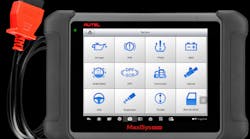Critical aspects of servicing the diesel particulate filter
When heavy duty vehicle technicians discuss maintenance, the conversation usually includes oil changes, brake checks, inspecting for coolant leaks and tire wear.
In addition, the diesel particulate filter (DPF) is also high on the list of vehicle components no technician should ever neglect. Failure to maintain the DPF and its supportive system not only will result in anemic acceleration and poor fuel performance but may result in damage to the filter itself, the exhaust system or engine.
Development of the DPF
The development of the DPF and its installation on all model year 2007 and newer heavy duty diesel engine vehicles made in the U.S., was prompted by the U.S. Environmental Protection Agency (EPA) Diesel Emissions Reduction Act. This initiative was implemented to reduce particulate matter released into the atmosphere by diesel fuel combustion, which is believed to cause asthma and other respiratory ailments, including lung cancer.
The DPF is usually made of ceramic composites and is installed as part of the exhaust system. Its layered walls trap soot and ash, the byproducts of fuel and oil combustion, preventing these residual toxins from escaping into the air.
It is not permissible to disable the DPF system. Not only will the system no longer operate as needed to remove particulate matter from the exhaust of the vehicle, but fleets may face penalties and fines if they do not adhere to U.S. EPA regulations.
Understanding the DPF
Instead of ignoring or dismantling the DPF, it’s important for fleets to take time to understand they system. This includes the best way to maintain it. Over time and use, soot builds up in the filter, constricting air flow and increasing pressure before the filter. Sensors, located before and after the filter, monitor the level of soot within the filter by measuring air pressure. When significant pressure is detected, the powertrain control module (PCM) initiates a DPF regeneration.
DPF regeneration, sometimes referred to as regen, is designed to automatically reduce the buildup of soot in the filter, and therefore reduce the pressure in the filter. Regeneration should not be confused with cleaning. DPF regeneration is actually the burning of the larger particulate matter into smaller ash.
Separately, cleaning a DPF involves removing the filter and bringing it to a shop that uses a thermal heating or forced air process to remove the caked soot. Such cleanings are said to restore the filter to close to 90 percent of manufacturer’s recommended back pressure. Instead of cleaning the DPF, fleets may also opt to replace the DPF.
Some fleets have started to include having the DPF cleaned every 120,000 miles as part of the per-vehicle maintenance plan.
Types of regeneration
There are three types of DPF regeneration: passive, active and forced. A passive regeneration uses a diesel oxidation catalyst (DOC) alone that acts to heat air before it reaches the filter. The vehicle must be driven at a significant speed for a period of 30 to 50 minutes to allow the exhaust temperature to rise high enough to adequately burn the soot.
Some fleets may never generate enough heat automatically, due to being driven locally with a series of stops and starts. An alternative type of regeneration was devised called active regeneration to handle these situations. An active regeneration injects extra fuel or diesel exhaust fluid to increase the temperature high enough to incinerate the trapped soot within the filter.
Neither passive nor active regenerations require the vehicle operator to take active measures. However, when both previous processes fail and a REGEN malfunction light displays yellow on the driver’s dashboard, it’s time to take real action. Fleets should not wait for the light to flash red and risk damaging the engine. It is important to note that regeneration will not be initiated if any engine codes are detected. To this point, it’s vital to address engine and exhaust system failures upstream from the DPF as these failures may have a critical effect on the DPF and the frequency and success of any type of DPF regeneration.
The third type of regeneration is referred to as manual regeneration, sometimes called a forced regeneration. This process must be completed in the shop by a technician, using a scan tool with manual regen capabilities.
Just like other vehicle diagnostics using a scan tool, technicians must plug the diagnostic tool into the vehicle’s OBD port. Depending on the scan tool used, condition of the filter and the vehicle type, a static forced regeneration can take up to an hour. Some vehicles require an in-motion forced regeneration whereby the vehicle would need to be driven at specific a speed and distance while the diagnostic tool is connected to the OBD port. An additional technician should be present in the vehicle while in operation to observe displayed process and provide feedback information from the diagnostic device.
A scan tool that can automatically scan all systems and view live data can provide information on how the engine is functioning, in addition to the condition of the DPF. Some scan tools may also have the ability to run a forced regeneration when passive and active regenerations have failed. When technicians are completing this service on the vehicle, they should also complete a thorough inspection of upstream systems such as the injectors, exhaust system and coolant system as well.
The DPF system is just one of the many systems so vital to optimum vehicle operation. Giving it proper attention and care is equally as vital to ensuring a fleet’s vehicles stay on the road and out of the shop.



